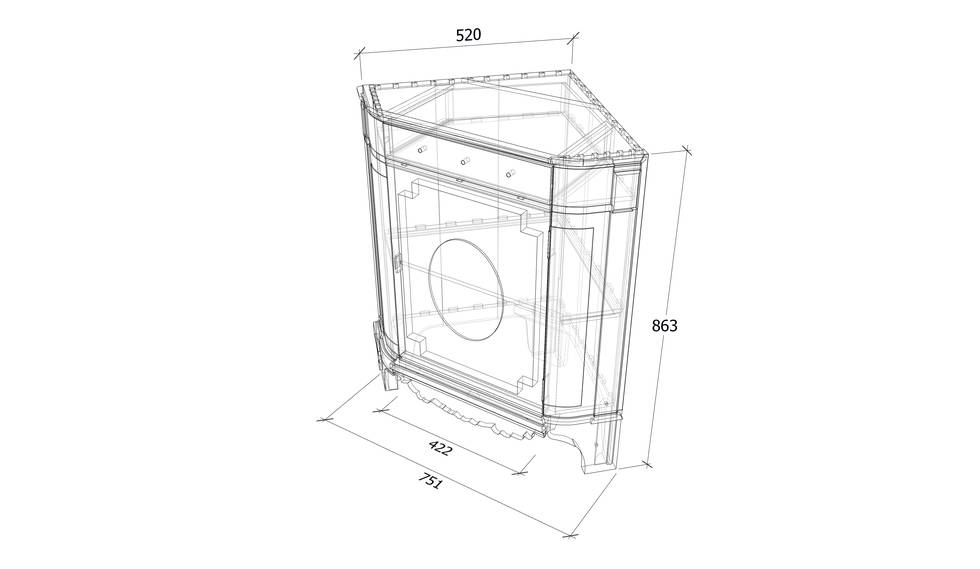Fall-front desk
Date: 1783
Maker: Cabinetwork by Jean-Henri Riesener; mounts attributed to Étienne Martincourt (chasing) and François Rémond (gilding); re-veneered, medallion added, about 1794–1825
Materials: Oak, burr wood (probably yew), purplewood, stained woods, ebony or ebonised wood, box, gilt bronze, Carrara marble
Measurements: 138.5 x 98.8 x 42.5 cm
Inv. no. F303
Corner-Cupboard
Date: 1783
Maker: Cabinetwork by Jean-Henri Riesener; re-veneered about 1794–1825
Materials: Oak, burr wood (probably yew), purplewood, stained woods, ebony or ebonised wood, box, gilt bronze, statuary marble
Measurements: 90.2 x 81.2 x 54.8 cm
Inv. no. F275
Whilst Marie-Antoinette regularly ordered new furniture for her private apartments, the royal furniture administration was adept at using and re-using pieces that she liked. This desk and corner-cupboard are examples of this.
They were initially ordered from Riesener as part of the refurbishment of her rooms at the Château de Marly, a small and private royal residence close to Versailles where a suite of tiny, intimate rooms was updated for her in the early 1780s.
However, instead of being delivered to Marly, the desk and corner-cupboard, along with a chest-of-drawers that went with it, were sent to Versailles where they were placed in the queen’s cabinet intérieur (private sitting room) in February 1783. There they stayed for just under a year, before they were sent to Marly for where they were intended.
The queen made only rare visits to Marly, and three weeks later the furniture was returned to Versailles, perhaps because she wished to have it in more regular use. It was placed in her new ground-floor apartment at the palace, where it stayed until it too was later replaced by a suite of plainer, mahogany-veneered furniture.
The fall-front desk is a model that Riesener produced in many variations and which was very popular with the royal family. It is a useful, functional object which must have suited well the smaller rooms of their private apartments. The frieze hides a drawer, below which the top half opens out to reveal an inner cabinet of small drawers and shelves suitable for holding papers and correspondence, with one drawer fitted out with containers for the ink, sand and pens used for writing. The fall-front itself provides a leather writing surface for writing on when it is in the open position.
The two doors below hide more shelves and a large strong box, which could be used to house more secret or confidential information, or even valuable objects. Each opening is lockable, and there are more secret compartments inside the desk itself. In an environment like the court where the queen was rarely allowed any time alone, it provided everything that was required for her to have some small measure of privacy.
Corner-cupboards were useful ways of providing a storage unit for a small space. In addition to the cupboard which it incorporates, and a small drawer above, the marble top would have been used as a display surface for objects such as small sculptures, precious porcelain or hardstone vases. In 1780, Marie-Antoinette had a corner-cupboard in her sitting room at Versailles where she displayed a bust of her daughter, known as Madame Royale (1778–1851), at that stage her only child.
Much of the beauty of the desk and the corner-cupboard derives from the lavish gilt-bronze mounts that decorate them. For this commission, Riesener produced new designs that incorporated motifs used in classical architecture and wild flowers, as well as heads of wheat grass that form the friezes running along the top. Delicate ribbons have been used as handles for the drawers, almost invisible in the frieze, and strings of pearls — Marie-Antoinette’s favourite jewels — run down the corner mounts and around the central medallions.
On the desk, a rectangular plaque is decorated with a charming spaniel and three small boys, one of whom is wearing a winged hat and holding a caduceus, a staff-like object that denoted the classical figure of Mercury, the winged messenger of the gods. These classical allusions were highly fashionable at this time, when neoclassicism had taken hold of interior decoration, but Riesener has worked with a softer, more playful version which clearly appealed to Marie-Antoinette.
It is likely that the mounts were supplied by Riesener’s long-term collaborator, the bronze worker Étienne Martincourt, who used this figure of Mercury elsewhere in his work.
The desk and corner-cupboard look very different now, however, to when they were first delivered by Riesener. Originally, they were veneered with marquetry, the characteristic trellis-pattern marquetry that Riesener used for much royal furniture. Instead of the gilt-bronze medallion in the middle of the desk, there would have been a marquetry panel, perhaps depicting a pastoral scene in keeping with the country surroundings of Marly. A similar arrangement, with trellis marquetry and a marquetry trophy, can be seen here, on this chest-of-drawers made for Versailles.
After the Revolution, the furniture was confiscated by the Revolutionary government and sold at a year-long sale of works of art taken from Versailles. At some stage over the next twenty years when taste changed towards a simpler look, the entire marquetry finish was stripped from the desk and corner-cupboard and replaced with what you see now.
Although this is relatively ‘plain’ in comparison with the marquetry that went before it, it is in fact a rather sophisticated veneer. Probably some type of yew wood, its particularly speckled appearance is not simply natural, but has been enhanced with many little wooden plugs which increase the figuring effect of the finish. It was at this time that the gilt-bronze medallion on the desk was also added, making it especially appealing to contemporary buyers for whom gilt bronze particularly appealed. Later in the 19th century, another corner-cupboard was made to match.
For more information: Jacobsen, H. et al., Jean-Henri Riesener. Cabinetmaker to Louis XVI and Marie-Antoinette. Furniture in the Wallace Collection, Royal Collection and Waddesdon Manor, London, 2020, no. 22, no. 23.

